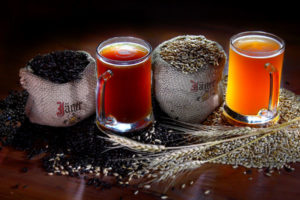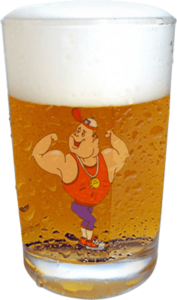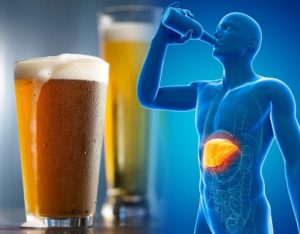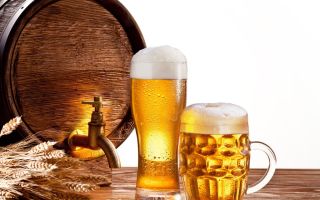Content
- 1 Types of beer
- 2 Composition, calorie content and nutritional value of beer
- 3 The benefits of beer
- 4 Why live beer is useful
- 5 The benefits and harms of unfiltered beer
- 6 Which beer is healthier: light or dark
- 7 Daily intake
- 8 Can i drink beer after exercise?
- 9 Is it possible to drink beer in the bath
- 10 Why is it bad to drink beer
- 11 Beer alcoholism
- 12 The harm of beer for a teenager
- 13 Beer for pregnant women and nursing
- 14 Conclusion
There is no consensus on the benefits and dangers of beer. Lovers and connoisseurs of this drink point to the rich vitamin and mineral composition, antioxidant, diuretic, bactericidal properties. Opponents and narcologists cite statistics on the development of beer alcoholism, including among women and adolescents. How does beer affect human health?

Types of beer
Producers and professional tasters classify beer according to various criteria: the composition of the raw materials, the method of making the wort, color, strength, country of origin.
In addition, one should distinguish between types and varieties of foamy drink. The variety is influenced by the fermentation method (top, bottom and spontaneous fermentation beer). The type of drink is determined by the color and production technology.
Classification of beer by color:
- Light - differs in a light yellowish tinge, pronounced bitterness, bright aroma, based on light raw materials (malt). The strength of the drink does not exceed 4 - 5%, and the density is 15%.
- Dark Is a traditional Bavarian drink with a dark brown color. The use of roasted malt imparts a light smoky flavor and a moderate hop bitterness to the beer. The fortress reaches 3 - 4.5%, the density - 11.5%.
In Russia, beer classification is popular depending on the production technology:
- Live - cooked at a temperature not exceeding 85 degrees, does not contain preservatives. The raw materials are based on live brewer's yeast cultures. Thanks to them, the drink has a short shelf life - 48 hours, after which it loses its useful properties.
- Filtered - undergoes cleaning, pasteurization and conservation, has a lighter, amber hue, but is devoid of most of the active substances. It is considered the most harmful.
- Unfiltered - retains some of the beneficial properties of a live drink. To extend the shelf life (up to 8 days after opening the package), a process of easy pasteurization and conservation is carried out. The harm of the drink is due to the use of low-quality preservatives, the accumulation of carcinogenic substances.
- Non-alcoholic - passes several stages of filtration, excluding alcohol from the drink. Beer retains some of the beneficial properties, the harm from alcoholic components to the body is minimal.

The taste, appearance, benefits and harms of beer are also determined by the type of raw material from which it is brewed. The type of wort is distinguished:
- barley;
- rye;
- wheat;
- corn;
- rice.
Most often, there are hybrid varieties made from several types of crops.
Composition, calorie content and nutritional value of beer
The harm and health benefits of beer are due to its chemical composition, calorie content, the presence of alcoholic components, and the content of various components.

Beer is 90 - 95% water, which has no particular effect on the body. The rest is carbohydrates (1 - 4.5%), ethyl alcohol (0.5 - 8%), proteins and carbon dioxide (0.2 - 1% each).
Beer includes a set of vitamins, macro- and microelements, amino acids. One bottle of beverage (0.5 l) contains:
- B vitamins - are responsible for the assimilation of proteins, fats, carbohydrates, the formation of muscle mass; strengthen the immune system, nervous system; regulate energy processes. A bottle of beer contains 9% of the daily requirement for vitamins B6, B8, B9, 4% each - B2, B5, B
- Vitamin PP - useful for blood circulation, heart and blood vessels (10% of the daily value).
- Macronutrients (phosphorus, calcium, magnesium, potassium, sodium) - strengthens bone tissue, blood vessels, heart; are responsible for muscle elasticity, joint mobility; participate in the formation of useful digestive enzymes. Beer contains 2 - 8% of the daily value of each element.
- Trace elements (fluorine, selenium, copper, manganese, iron) - regulate the quality, quantity, composition, blood clotting; blood pressure; are responsible for the water-salt balance. The drink replenishes 2 - 6% of the need for each element.
The benefits of a moderate amount of beer for the human body are due to its low calorie content, which practically does not depend on the type or variety of the drink. A glass of beer (250 ml) contains about 100 - 130 kcal.
The benefits of beer
The benefits of the drink are characterized by the content of the vitamin and mineral complex, which has a beneficial effect on the body. Moderate use:
- stimulates digestion;
- normalizes the intestinal microflora, gastric mucosa;
- helps to fight nervous disorders;
- prevents the development of diabetes, stroke, heart attack;
- lowers cholesterol;
- good for memory;
- removes toxins, stimulates the liver;
- possesses bactericidal properties;
- minimizes the risk of kidney stones.
The benefits of natural beer are due to the presence of flavonoids and antioxidants that improve well-being and appearance.
Hops, which are part of a quality drink, contains xanthohumol. According to scientists, the substance blocks harmful age-related changes in the brain, prevents the development of Alzheimer's and Parkinson's diseases.
For women
The benefits and harms of beer for women are ambiguous, depending on the dosage, the quality of the drink, the presence of concomitant diseases.
Use in small doses:
- promotes weight loss, accelerates metabolic processes;
- relaxes, relieves stress, helps fight insomnia;
- has analgesic properties;
- saves from skin aging.

The hop cones used to prepare the drink are rich in phytoestrogen, a substance similar in properties to female sex hormones. The benefits of beer contained in natural herbal ingredients are obvious to the female body. The drink helps to align hormones, cope with depression and mood swings.
The soothing and normalizing properties of the drink are also relevant for women over 40. Beer helps fight the unpleasant and harmful manifestations of age-related hormonal changes, improves health during menopause.
The drink found wide application in home cosmetology. It serves as the basis for useful masks, decoctions, creams, balms for the face, neck, hair.Beer rejuvenates, removes wrinkles, traces of the harmful effects of the urban environment, helps fight skin diseases.
For men
The benefits of beer for men have been proven only when consumed in small quantities by healthy people who do not have chronic diseases, inflammatory processes or hormonal disorders. Foamy drink:
- lowers cholesterol, prevents heart attack, stroke;
- prevents the occurrence of prostatitis, urolithiasis;
- thanks to its soothing properties, it fights insomnia and stress;
- used in male cosmetology - effectively eliminates dandruff.
The benefits and harms of beer for men depend primarily on the dosage. Moderate consumption will not harm health, relaxes, stimulates the brain, kidneys and liver. Abuse will lead to alcoholism, impotence, obesity.
Why live beer is useful
The benefits of live beer are in the absence of preservatives, filtration and pasteurization processes. Low processing temperature preserves the properties of plant components, vitamins, and the viability of brewer's yeast.

Live drink:
- has diuretic properties, stimulates the liver, kidneys;
- improves sleep, calms, relaxes;
- stimulates metabolism;
- normalizes digestion, cholesterol levels;
- has anti-inflammatory properties.
Live beer retains its benefits for 2 days after production. The dosage, the presence of diseases and contraindications for use are important.
With chronic inflammation of the gastrointestinal tract, psychoemotional disorders, hypertension, heart disorders, the drink will harm health, aggravate and exacerbate the course of the disease.
The benefits and harms of unfiltered beer
Unfiltered product retains most of the properties of a live drink. It contains a significant proportion of brewer's yeast, which is responsible for its benefits.
The quality drink contains an enriched complex of vitamins and microelements. Useful composition of the product:
- protects against cholesterol deposits;
- reduces the risk of heart attack;
- stimulates the production of gastric enzymes, the work of the excretory system.
Connoisseurs of unfiltered beers appreciate the benefits of natural wheat beers fortified with antioxidants. The drink perfectly quenches thirst, regulates water balance, and speeds up metabolism.
The harmful effects on health are due to the presence of alcohol in the product. Excessive alcohol addiction destroys the liver, disrupts the work of the heart and brain.
Which beer is healthier: light or dark
For the production of dark and light beers, light or special dark malt is used, respectively. The dark color is obtained due to the technology of frying the ingredients. In this case, the basis of the dark drink is the same light malt with the addition of a certain amount of burnt (or roasted) raw materials.

As a result, the harms and benefits of different beers with similar strength and gravity characteristics are identical.
However, there are studies by American scientists that prove the benefits of dark beer. In 2003, John D. Folts found out that such varieties contain more antioxidants, thin the blood, prevent the occurrence of thrombosis, atherosclerosis, and cholesterol deposits.
A little later, in 2011, Spanish researchers found that dark varieties have a higher iron content, which also has a beneficial effect on the properties of beer and its effect on the circulatory system.
Alcohol studies have been conducted on animals (rats and dogs). The special benefits of dark beer for humans have not yet been proven.
Daily intake
The harm of beer is due to the presence of ethyl alcohol in its composition, which has a destructive effect on all human systems and organs. In addition, the drink acquires harmful properties as a result of the use of low-quality raw materials, violation of conditions, storage and transportation periods.
Safe daily intake of a quality drink:
- for men - no more than 0.5 liters, no more than 3 - 5 times a week;
- for women - no more than 0.3 liters, 2 - 3 times a week.
A live product contains less harmful impurities, it can be drunk more: up to 0.7 liters for men, up to 0.5 liters for women.
Narcologists do not recommend drinking foamy drinks every day. Even one bottle of beer a day can lead to the development of alcohol dependence.
The non-alcoholic drink is not so harmful, the alcohol content in it is minimal. You can drink more of this beer.
At the same time, you should not drink non-alcoholic products while driving, when working with power tools, on machines, carrying out high-rise and other similar work. Even a small dose of alcohol can be harmful: the reaction speed decreases, attention is dulled, motor skills are impaired.
Can i drink beer after exercise?
The benefits of foods containing B vitamins for sports have long been proven. They stimulate a set of muscle mass, relax, and restore strength after training.
The percentage of B vitamins in beer is not high compared to other, safer, healthier foods. At the same time, the presence of a harmful alcoholic component increases the load on the heart, brain, circulatory system, can cause heart attack, stroke, hemorrhage. Powerful diuretic properties dehydrate the body and disrupt the water-salt balance during and after physical activity.

Professional trainers warn about the dangers of beer for the athlete engaged in intense training. Alcohol in the blood slows down the breakdown of fats and muscle recovery, disrupts metabolism, and interferes with protein synthesis. Just 500 ml of a foamy drink, harmful for exercise, completely neutralizes the beneficial effect of physical exertion.
Also, beer and bodybuilding training are incompatible. The high content of substances - phytoestrogens smoothes out the relief of muscles, saturates the body with female hormones, blocks the production and assimilation of testosterone.
Alcohol contained in strong grades also has a harmful effect on the muscle mass of a bodybuilder. It has powerful destructive properties, it eats away the protein component of muscle fibers.
Is it possible to drink beer in the bath
Disputes about the dangers and benefits of beer in the bath do not subside. Fans of the foamy drink claim that its use in the steam room:
- strengthens the nervous and immune system;
- improves blood circulation, digestion, sleep;
- stimulates the work of the cardiovascular, excretory systems;
- removes toxins, heavy metal salts.
The beneficial properties of the plant components of beer are revealed when it is heated to 40 degrees. Natural extracts of malt and hops in a heated drink have a general strengthening, bactericidal effect due to intense sweating.
Opponents of drinking in the steam room highlight the harm alcohol can do to the heart and brain. The human body at a high temperature in the bath experiences increased stress: the heart rate increases, blood pressure rises.
Beer can aggravate the harmful effects of temperature, especially for people suffering from cardiovascular diseases, cause arrhythmia, stroke, heart attack.
Beer in the steam room will benefit or harm, depending on the dosage. Doctors and avid bath attendants do not recommend drinking more than 0.5 liters of a quality drink.
Why is it bad to drink beer
Beer, especially cheap beers, contains alcohol that imperceptibly causes the development of addiction. Abuse has a detrimental effect on the entire human body, affecting all systems and organs, disrupting their work.
The brain, heart, digestive organs, urogenital system suffer from the harm of foamy drinks, obesity develops.
Supports weight gain
Beer has a relatively low calorie content. A glass of frothy drink can be compared to a glass of milk or orange juice.
The composition of the beer, its effect on the chemical processes in the body, causes harm to the figure. The alcohol contained in alcoholic products interferes with the proper processing of carbohydrates, blocks protein synthesis. Due to these reactions, carbohydrates are processed into harmful fat, deposited on the internal organs, the walls of blood vessels, the so-called beer belly appears.

Beer obesity is common in both men and women. In addition to the harmful drink, a high-calorie, salty snack, a sedentary lifestyle, and weak abdominal muscles contribute to its development.
Destroys brain cells
Alcohol-containing drinks, including beer, destroy brain cells that enter the circulatory system and are excreted in the urine through the kidneys.
Passion for harmful foamy drinks leads to a decrease in mental abilities and learning, memory impairment. The development of beer alcoholism can cause dementia.
Destroys the liver
The liver performs a protective function in the body, relieves intoxication. Harmful alcoholic components weaken the protective barrier, the organ wears out.
Beer provokes the development of inflammatory processes in the liver, which leads to cirrhosis or hepatitis.

Causes cardiovascular disease
The harm from uncontrolled drinking of beer affects, first of all, the cardiovascular system, causing the development of "bovine (Bavarian) heart syndrome".
Foamy drinks, rich in cobalt and harmful carbon dioxide, increase blood volume and thin it strongly. The heart muscle, pumping excess fluid, works for wear, stretches, becomes flabby, becomes overgrown with fat.
As a result - early fatal heart attacks, strokes, varicose veins.
Irritates the stomach lining
Beer alcohol irritates the stomach lining and causes copious secretion of gastric juice. The acid stimulates the development of inflammatory processes, which ultimately lead to gastritis, gastric ulcer, atrophy of the pancreas.
Impact on the reproductive system
The harmful properties of phytoestrogen, the female sex hormone contained in beer, are detrimental to the male body. They block the production of testosterone, which is responsible for reproductive functions.
A lack of male hormones, against the background of an abundance of female hormones, suppresses attraction, reduces the quality and quantity of seminal fluid, which leads to impotence and infertility.
The harmful effect of beer affects the female reproductive system. An excess of estrogen promotes the proliferation of the uterine epithelium, causes the growth of polyps, and disrupts the menstrual cycle.
Beer drinkers are more likely to develop cancerous growths in the breasts and pelvic organs, and the chances of conceiving, bearing and giving birth to a healthy child are reduced.
Beer alcoholism
The danger of beer alcoholism lies in the difficulties with its diagnosis. For years, an addicted person may not admit the existence of an addiction, more and more often kissing a beer bottle.

External signs of the disease are similar to "vodka" alcoholism, but have characteristic features:
- loose body, female obesity;
- bags, cyanosis under the eyes;
- general swelling;
- heavy breathing, shortness of breath.
In addition to external signs, there is:
- decreased sexual activity, infertility, impotence;
- headaches, aching sensations in the right hypochondrium;
- prolonged diarrhea;
- general weakness, dizziness, sleep disturbance;
- irritability, temporary memory loss.
Signals for the development of addiction are:
- drinking more than 1 liter of drink daily;
- desire to get drunk;
- drinking in large quantities, regardless of the occasion, time of day, company, quality of the drink;
- apathy in the absence of libations, excessive gaiety after.
Beer is considered a harmless, low alcohol drink. At the same time, dependence occurs several times faster than from strong types of alcohol. Female and adolescent alcoholism develops more intensively, has more harmful and often disastrous consequences.
The harm of beer for a teenager
The harmful effects of foamy malt drinks on life and health are especially pronounced at a young age. Beer drinking in teens leads to:
- to the rapid development of adolescent beer alcoholism;
- aggressive, asocial behavior (as a result, early marriages, abortions, problems with law enforcement agencies);
- violation of hormonal levels, the development of infertility;
- malfunctions of the heart, kidneys, liver.

Beer for pregnant women and nursing
Doctors agree that beer is contraindicated for a pregnant or lactating woman. The drink causes significant harm not only to the mother, but also to the child.
Non-alcoholic varieties are controversial. Women believe that the harm from such beer is minimal. At the same time, the drink enriches the body with vitamin B, useful microelements, prevents the occurrence of edema, and soothes.
Experts emphasize the harmful properties of beer and its components:
- The presence of alcohol. Non-alcoholic varieties contain up to 0.5% alcohol. It is not retained by the placenta, it enters the child's body through the mother's blood or milk.
- High concentration of carbon dioxide - harms the digestive system: causes bloating, problems with digestion, disturbance of the stool. Constipation leads to intoxication of the body, diarrhea leads to dehydration.
- Harmful substances that make up the drink, carcinogens, low-quality raw materials.
- Live brewer's yeast in unfiltered varieties - can cause allergies, individual intolerance.
Regular consumption of alcohol-containing beer is detrimental to women's health, especially during the period of childbearing and breastfeeding. At this stage, the protective properties of the body are weakened, the psychoemotional state is unstable, which can lead to rapid damage to internal organs and the development of alcoholism.
Conclusion
The health benefits and harms of beer is a relevant topic, giving rise to ongoing controversy. Excessive passion for foamy alcoholic beverages, and even low quality, disrupts the work of the digestive system, genitourinary, cardiovascular system, leads to alcoholism, social problems. Drinking high-quality, expensive varieties, on the contrary, will be beneficial, have a tonic, calming effect, stimulate the work of the brain, kidneys, liver, and improve mood and appetite. Subject to the recommended norms and a meticulous approach to the choice of the variety, beer will not bring significant harm to health and in many ways will even be useful.

